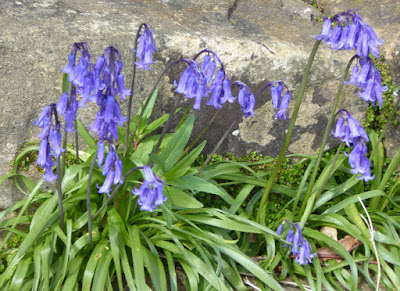In 894 AD, things weren’t going well for King Alfred. An army
of marauding Danes had sailed up the Lea Valley, seemingly looking
for somewhere to set up a base – they’d even brought wives and children with
them. They established a fortified camp by the river some twenty miles north
of London and a direct attack by Alfred’s troops failed to dislodge them. So the
wily king tried another tactic – he diverted or blocked the river, trapping the
invaders and their ships. With winter approaching and few provisions, they were
forced to abandon their vessels and retreat, some to Northumbria, others returning
to the continent. After that, they more or less gave up. The exact site of
Alfred’s triumph isn’t known, but on our latest walk, from Cheshunt to
Broxbourne, we spotted this small replica of a Viking ship (above) at the Lee
Valley Boat Centre – a fitting reminder.
It was a very peaceful walk, punctuated
by the cries of Canada Geese and the occasional chugging canal boat.
At Kings Weir (above) our walking group met fishery manager Barbara
Newton, whose family have been associated with the area for several generations.
She told us of the wide range of fish and wildlife that frequent the area –
Barbel are a speciality, and can reach up to 16lb. There are also bream,
perch, pike, roach and dace.
Back on the Lea Navigation, we passed a swan nesting
patiently right by the towpath, and some imaginative floral decorations on one
of the many canal boats moored there.
Lunch was at the Crown Inn, which has
served Broxbourne for several hundred years. (The current building replaced the
old Crown in the 1930s.) Then there was time for a visit to Broxbourne’s
historic church, St Augustine’s.
Though the door was shut, the people at the Parish Centre
kindly unlocked it and said we could stay as long as we wanted. The parish is
mentioned in the Domesday book of 1086. The date of the original chancel and
nave aren’t known, but the church was rebuilt and enlarged around 1460,
probably by the Lord of the Manor, Sir John Say.
The chest tomb of
him and his wife Elizabeth, the brasses still resplendent with coloured
enamelling, is still in the church and is a National Monument.
Nearby is the Cock family memorial, a splendid
dresser tomb with life-sized effigies. Sir Henry Cock was ‘keeper of the
wardrobe’ to Elizabeth I, which might explain his lavishly decorated armour. We also
paused to read some of the inscriptions on the stones set in the floor. One
remembers a Charles Hamilton, who ‘departed this life in 1751, aged 60, and ...died
richer in a good name than wealth, and all who knew him loved him.’ A sign of how different life once was came from a Benefaction
board just inside the entrance, showing charitable gifts going back to 1440. They include one from Sir
William Thorowgood who in 1602 bequeathed ’26 wheat loaves, at 13 to a shilling ‘ to be
given out each Sunday for ever, and provided for six sermons a year.

Outside
again, and the New River, an artificial waterway
opened in 1613 to supply London with fresh drinking water, took us past the
churchyard and its spring blossom and back to the Lea - and the rail station. Although the name Broxbourne is believed to derive
from the Old English brocc and burne, meaning badger stream, no badgers were spotted
on this walk. However, the water vole apparently thrives in Silvermeade meadows,
just south of the town.































